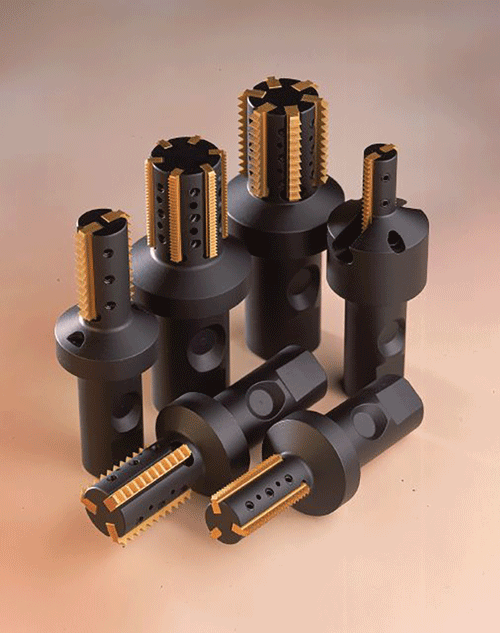When Thread Milling Makes Sense
Threading a workpiece is a fundamental metalworking process that every manufacturing engineer takes for granted.
Threading a workpiece is a fundamental metalworking process that every manufacturing engineer takes for granted. Yet, by any measure, this commonplace process is by no means as simple as it sounds.
Tapping tends to be used primarily to make threads in small holes and ranges from 00-90 taps to taps that can measure up to, and sometimes exceed, 4 inches in diameter.
Under magnification, the tapped hole will appear a bit jagged because the tap’s flutes cut where the chips tend to get caught and sometimes jam the tap, which can tear the thread. Threads cut with a tap are not of the same quality as milled threads.
Less familiar, even to experienced manufacturing engineers, is thread milling using either solid carbide thread mills or steel holders with indexable inserts. Traditionally, thread milling has been applied primarily to large workpieces. Now, solid carbide thread mills can produce threaded holes as small as 0.25 inch, and better programming software has thread milling making its mark in many shops.
Thread milling surfaced approximately 25 years ago in response to NASA’s need to machine high-quality threaded holes in tough materials such as titanium, Hastalloy and Inconel – a difficult feat with a tap. Through the years, thread milling has evolved, and manufacturers are now using the process to produce strong, exceptional threads in hardened materials up to 70 Rockwell.
Here are six reasons to consider thread milling:
Thread milling achieves a better thread quality than tapping because the threads are being properly machined with the clearance needed to evacuate the chip, using a tool that is smaller than the threads themselves. Tapping uses a tool the same size as the thread, forcing the chip through the thread form for evacuation.
Depending on the hole diameter, tapping can be performed either by hand or machine. Thread milling, however, requires use of a machine tool usually with CNC capability.
Thread milling is easier on the machine tool because it requires lower cutting forces than tapping.
Because thread milling uses helical interpolation, it isn’t necessary to have the hole right on size because the thread mill will cut the hole larger. When operators tap, they drill the hole larger than necessary because it is easier. However, in doing so, they lose part of the thread and reduce its overall strength.
It’s common for small taps to break during the tapping process. Once it is broken, removing the remnants of the broken tap from the hole can be time consuming, but more often than not, a broken tap results in a scrapped part.
With thread mills, either right- or left-handed threads can be produced using the same tooling.
While thread milling is a practical solution for threading large holes, it demands a careful and deliberate approach. First, it requires CNC machines with at least three-axes for helical interpolation. Second, either the machine operator or manufacturing engineer must be able to write and understand the necessary computer program for thread milling or have access to thread milling software or CAM programming software that includes thread milling options.
The depth of the thread is an important consideration as well. Usually depth is no more than one and a half times the diameter of the hole. The reason being is that the longer the milling tool, the more chance it can experience deflection, which can create inaccuracies in the thread.
With thread milling, there are a couple of tooling options from which to choose. They are either a solid carbide or indexable tool. Solid carbide tools are especially useful for smaller hole sizes because an indexable tool typically won’t fit in holes that are 0.625 inch or less in diameter. In terms of cost, solid carbide thread mills are more expensive than indexable designs, but can be cost effective depending on the quality needed and the lot size. However, with an indexable tool, once the thread mill body is purchased, the cost to produce threads is only in replacement inserts. Indexable tools also have shanks made of steel, which makes them more forgiving than solid carbide tools.
Last, taking advantage of Seco’s thread milling wizard software, which is available via the company website, can speed and smooth the transition from tapping to thread milling. The software asks a series of questions about the type of thread being produced, and based on the responses, it will create a highly effective, tailor-made CNC program for use with the machine tool: It’s a knowledge-based programming tool that has been proven helpful.
Related Content
The Value of Tool Monitoring on Rotary Transfer Machines
By using a tool monitoring system, shops can save costs associated with machine maintenance and downtime for tool changes while increasing cutting performance.
Read MoreAutomation Breakthroughs Revolutionize Precision Machining for Complex Parts
Marubeni Citizen-Cincom delivers custom solutions to address some of the biggest challenges in precision machining from handling small parts, to robot integration and unique tooling needs.
Read MoreBroaching Tool Technology For Lathes Used to Slot Inconel Parts
This shop finds value in using an indexable-insert-style broaching tool to create blind-hole slots in heat-treated Inconel aerospace parts on a CNC lathe.
Read MoreBreaking the Barriers for Small Tool Breakage Detection
This contact-free tool breakage detector, especially useful for machine tools with small tools and small workzones, offers a quick and efficient way to change out broken tools before they cause bigger problems.
Read MoreRead Next
A Tooling Workshop Worth a Visit
Marubeni Citizen-Cincom’s tooling and accessory workshop offers a chance to learn more about ancillary devices that can boost machining efficiency and capability.
Read More5 Aspects of PMTS I Appreciate
The three-day edition of the 2025 Precision Machining Technology Show kicks off at the start of April. I’ll be there, and here are some reasons why.
Read MoreDo You Have Single Points of Failure?
Plans need to be in place before a catastrophic event occurs.
Read More









.png;maxWidth=300;quality=90)














